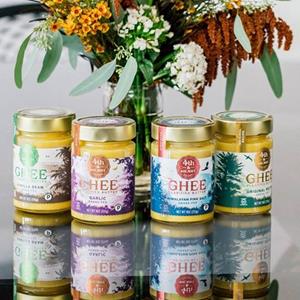Buttered Up: 4th & Heart Gets $10M To Scale Ghee Stick Production

With an eye towards scaling its ghee stick innovation, 4th & Heart has secured a $10 million growth equity investment led by existing investor Cambridge Companies SPG. The raise also included investment new and existing investors including Boulder Food Group and Harbinger Ventures as well as 15 professional athletes and several food industry operators and influencers.
“The business has seen an outsized amount of growth relative to our capacity in our [current] facility,” CEO Max Dichter told NOSH today.
More capacity will come in the form of expanding the manufacturing capabilities in the company’s existing 30,000 sq. ft. production facility. which will scale production of the company’s ghee sticks. 4th & Heart moved to self-manufacturing last year, receiving $1 million from Bridge Finance Group to help the brand acquire new equipment. Presently, the brand operates out of a manufacturing facility and fulfillment warehouse but will use the new capital to pay for “proprietary equipment” within the existing additional space to keep up with growth and demand for the ghee sticks.
The company owns all its own equipment and oversees all production itself but leases the buildings.
The purpose of the round is to “increase revenue output capacity, to bring that capacity to about $175 million” , said Filipp Chebotarev, Cambridge Companies managing partner and COO, giving the company flexibility in how it can grow, especially with its ghee stick innovation.
The sticks are currently in the chilled dairy case in about 1,200 retail doors, the sprays are in 2,300 stores. Whereas, 4th & Heart’s jarred ghees are on ambient shelves in 16,000 stores; yet, in locations where both sticks and jars are both sold, the sticks are already “meeting and exceeding the velocities” of the jars, Dichter said. Currently, the sticks are sold in retailers including Kroger, Whole Foods and specialty stores like Citarella and Erewhon.
The new round places Cambridge with about 30% ownership in the business. Cambridge has invested $175 million since it was founded in 2016 across 20 companies including Once Upon A Farm, Tosi Health, Nona Lim and The Coconut Cult.
Though the “first close” was in mid-November, Chebotarev said, there is an “opportunity to stretch a little beyond that” and there are ongoing talks with existing and new investors to add to the current round.
With this round, 4th & Heart has raised at least $26 million including equity and equipment debt financing.
Founded in 2014 by Raquel Tavares as Tava Life, the company rebranded in 2016 to 4th & Heart. Tavares helped grow the brand into other categories before leaving the leadership team in 2020.

Using ghee as the launching board to other products, the brand has tried to diversify into value-added products like snack bars and flavored varieties with limited success. The bars and chocolate ghee have been discontinued as the company has focused on its core line of jarred, sprayable and stick formats of clarified butter.
The brand is bullish on its ghee products with sticks and sprays diversifying the company out of the ethnic aisle in-store and into the premium butter set. The total addressable market across 4th & Heart’s three main product platforms is estimated to be about $20 billion, Chebotarev said.
Butter is a $5.6 billion category, with 4th & Heart operating in what it calls the “premium butter” subcategory which is growing at a 12% CAGR, according to Dichter.
“What we’re seeing there is not only dollar growth in that category, but unit growth which is really demonstrating that consumers are shifting their purchasing behavior away from traditional butter and butter alternatives toward premium butter,” he said.
Though there is planned innovation coming in the next two years the brand is focused on scaling its current products to expand into the whitespace in premium butter and dairy that is currently available.
“The chemistry that we have involved in making this product is so unique and so innovative that we’re able to do something that can be highly disruptive to the dairy set [and] the butter category itself,” Dichter said. “One thing we’ve learned over time is that focus is sometimes more valuable than spreading yourself across many initiatives.”


















